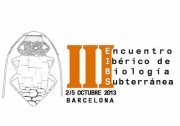Invited oral talk:
Tales of the unexpected: Portugal, a world hotspot for subterranean fauna?
ABSTRACT
Worldwide, the definition for subterranean biodiversity hotspot is based in the presence of >20 troglobiont or stygobiont species per cave or well. The cave-dwelling fauna from Portugal has been traditionally classified as poor with some relictual fauna, but the recent years of intense biological prospections in caves revealed an unexpected high diversity, especially in caves from southern Portugal.
The Algarve is nowadays the richest massif of Portugal, harboring an interesting amount of relicts and the promise of its increment with standardized sampling in the future. After this study a question is launched: do we have a new cave-dwelling diversity within the Iberian Peninsula, located in Portugal?
Poster presentations:
Reboleira A.S.P.S., Gonçalves F., Oromí P. & Abrantes N. (2013). Ecotoxicology of groundwater: acute toxicity in stygobionts
ABSTRACT
Karst systems harbor large groundwater resources for human consumption and represent an important habitat for rare and unprotected specialized animals, the so-called stygofauna.
Due to the highly adapted features towards subterranean life-style, together with the geographic isolation provided by the subterranean aquifers, groundwater-dwelling animals may lose the ability to face sudden changes on their ecosystems, and therefore the risk of extinction is remarkably high. Little is known about their sensitiveness, especially linked to contamination pressure in urbanized karst areas. Understanding the impact of contaminants on stygofauna is important for setting groundwater environmental quality and management of karst systems.
We have investigated the acute toxicity of copper sulfate and potassium dichromate on two endemic stygobiont species of the peri-Mediterranean genus Proasellus from two different karst areas in Portugal.
Groundwater from both sites was characterized in order to depict possible responses resulting from the long-term exposition of organisms to pollutants. Resistance of stygobiont Proasellus spp. To toxicity was compared with bibliographic values for stygobiont species and with the epigean standard species Daphnia magna. The less groundwater-adapted P. assaforensis revealed to be more tolerant to acute exposure to both toxics, suggesting that the degree of adaptation to groundwater life can influence the acute response of Proasellus spp. to pollutants. On the other hand, the tolerance to wide environmental conditions could be seen as a key factor in groundwater colonization. This study highlights the need using local specimens to infer the effects of pollution in their corresponding karst systems, which is important to define specific environmental quality thresholds for groundwater ecosystems that will certainly contribute for its protection.
de Figueiredo D.R., Saraiva P., Condesso de Melo M.T., Oliveira J., Gonçalves A.M.M., Reboleira A.S.P.S. & Abrantes N. (2013). Bacterial diversity as a tracker to assess connections and pollution impacts through the aquifer of Estremenho karst massif
ABSTRACT
The vulnerability of aquifers is expected to increase in the next decades not only due to climate changes (long and severe drought periods) but also to pollution pressure. Therefore, it is of major importance to track drastic changes in biodiversity as a stress indicator.
Within the scope of the KARSTRISK project, a detailed groundwater survey has been carried out in the Estremenho karst massif (central-western Portugal), in order to assess the groundwater bacterial diversity in a set of 22 geographically sparsely distributed samples.
This aquifer is used for drinking water supply and it is a regional river base flow, having a large variety of dependent ecosystems that are highly vulnerable to groundwater quantity and quality variations. The present work takes advantage of molecular culture-independent methodologies such as PCR-DGGE (Polymerase Chain Reaction – Denaturing Gradient Gel Electrophoresis) and sequencing in order to study the diversity in bacterial community from groundwater samples.
Preliminary data reveals the existence of shared bacterial community patterns among some samples, which suggests a hydrological connection between them. Considering that Estremenho karst massif is severely impacted by anthropogenic pressures (e.g. agriculture, tanning industries, automobile repair garages, olive oil mills and urban areas), it is important to highlight potential pollution pressure throughout the karst system. The present work gives exploratory insights on the use of the bacteria as a key-community to track environmental variations on groundwater quality.
Stokkan M., Reboleira A.S. & Jaume D. (2013). A new species of Pseudoniphargus (Amphipoda), from the Azores archipelago.
ABSTRACT
Based on new material collected on the island São Miguel there is basis to introduce a new species of Pseudoniphargus to the Azores archipelago. Since the expedition in 1957 of Erik Dahl and Per Brinck and later described by John Stock the species Pseudoniphargus brevipedunculatus have been the only species connected to the Azores archipelago. Based on taxonomic and morphological data as well as molecular analysis, we have reason to conclude novel ideas about the evolution of Pseudoniphargus from the Azores archipelago.

 RSS Feed
RSS Feed
